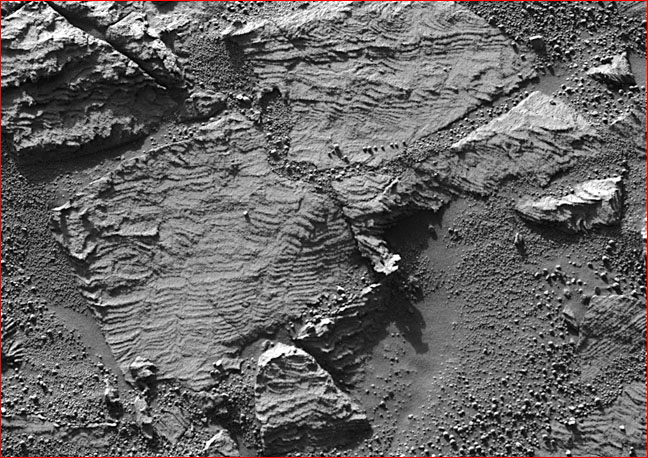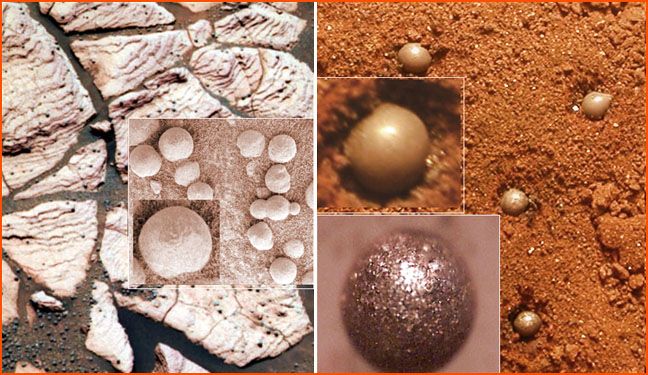Skip to comments.
“Festoons” Add to Martian Mysteries
Posted on 01/19/2006 6:12:34 PM PST by Swordmaker
|
Jan 16, 2006
"Festoons" Add to Martian Mysteries Swirling and layered Martian ?sediments? have inspired planetary scientists to see deposition from shallow water. But the electrical theorists point to a more powerful force active in the Martian past.

Credit: NASA/JPL-Caltech/Cornell
The image above comes from the panoramic camera on NASA's Mars Exploration Rover Opportunity, taken on January 2, 2006). NASA scientists describe this as the best example yet of the Meridiani Planum outcrop rocks on the margins of "Erebus Crater". The image shows well-preserved, fine-scale layering and what geologists call "cross-lamination". Of particular interest to planetary scientists are the nested "smile-shaped" patterns that sedimentary geologists call "festoons". These geometric patterns, they say, imply the presence of small, sinuous sand ripples that form only in water on Earth. According to a news release from the Jet Propulsion laboratory, "these features are the preserved remnants of tiny (centimeter-sized) underwater sand dunes formed long ago by waves in shallow water on the surface of Mars". This explanation requires liquid water flowing on the surface of a freezing desert planet. In other words, it requires a vastly different environment on Mars in the past. The explanation is also limited to observations of rocks on Earth that have been interpreted under the questionable geological framework of the uniformity principle: "things happening today are the best indicators of things that happened in the past." Many decades ago this assumption hardened into dogma, and it has led to a litany of unresolved puzzles on Earth. In the space age it is a poor tool indeed for understanding what we find on Mars. The dilemma has a simple resolution: stop ignoring electrical events inscribed on Mars. Electrical phenomena, both ancient and modern, range from observed global dust storms and electrical dust devils to the vast scars of electrical discharge in the past. For those familiar with electrical scarring phenomena, the most outstanding features on Mars - Olympus Mons and Valles Marineris - shriek of stupendous electrical arcs carving the surface of the planet. According to the electrical theorists, electrical events vastly more powerful than standard geological processes have shaped the solid planets and moons in the solar system. Atmospheres and surface material have been lifted from one body and fallen back or have been dumped on another. In the process, elements and compounds were modified and dust and melted spherules were formed, to rain down upon a planet. These deposits were then heated by surface electrical currents that changed sand into sandstone, recording the layered deposition and electrical erosion occurring at that time. Evidence for electrical exchanges between planetary bodies demands that we give up our cozy belief in a nearly eternal, clockwork solar system. The new data from space make clear that Mars was on a different orbit in the past, a consideration that greatly expands the possible explanations for the puzzling images sent to Earth by our Mars probes and surface rovers. Mars must have had a quite different atmosphere and climate in the past. So from this perspective, surface features that show "water action" on the frozen desert planet are not unexpected. Planetary scientists, however, have been unaware of a fact that could change our understanding of planetary surfaces and the surfaces of other rocky bodies in the solar system. Electrical discharge machining, electrical winds, electrostatic cleaning, and electrostatic implantation can do everything that water can do - and a good deal more. Electrified plasma can mimic the behavior of fluid dynamics, while adding energies many thousands of times more powerful than fluid erosion. The key to the "festoons" on Mars is evident in the pictures themselves. These curious patterns are surrounded by the now-famous "blueberries" occurring on the Martian surface by the trillions. Experiments have never produced counterparts to the Martian blueberries by depositing hematite from water. But laboratory experiments have produced precise counterparts with electrical arcs. |
|
|
EXECUTIVE EDITORS: David Talbott, Wallace Thornhill MANAGING EDITOR: Mel Acheson
CONTRIBUTING EDITORS: Michael Armstrong, Dwardu Cardona, Ev Cochrane,
C.J. Ransom, Don Scott, Rens van der Sluijs, Ian Tresman
WEBMASTER: Michael Armstrong Copyright 2005: thunderbolts.info
|
TOPICS: Astronomy; Science; Weird Stuff
KEYWORDS: electricuniverse; mars; thunderbolts
To: Swordmaker
2
posted on
01/19/2006 6:14:31 PM PST
by
Swordmaker
(Beware of Geeks bearing GIFs.)
To: Swordmaker
Yep it is the most simple answer for these deposits - what pure BS gets posted as science..too many educated beyond their intelligence.
3
posted on
01/19/2006 6:26:51 PM PST
by
ConsentofGoverned
(if a sucker is born every minute, what are the voters?)
To: Swordmaker
Richard C. Hoagland still thinks its due to Aliens. [/not really if only because he hasn't said anything about it...but I wouldn't be surprised]
4
posted on
01/19/2006 7:12:45 PM PST
by
Simmy2.5
(There are more conspiracies at DU then there are on Coast to Coast AM.)
To: Swordmaker
WARNING! WARNING! WARNING!Kook alert. You have been warned.
5
posted on
01/20/2006 7:17:25 AM PST
by
cogitator
To: Swordmaker; 75thOVI; AndrewC; Avoiding_Sulla; BenLurkin; Berosus; CGVet58; chilepepper; ckilmer; ...
Thanks Swordmaker for the topic.
6
posted on
01/20/2006 8:45:46 AM PST
by
SunkenCiv
(In the long run, there is only the short run.)
To: SunkenCiv; Swordmaker
"Atmospheres and surface material have been lifted from one body and fallen back or have been dumped on another." And/or, as conjectured by Sitchin in 1976 ("12th Planet" pg 231, describing the collision of Nibiru (Marduk) and Tiamat:
'During that collision, the life-bearing soil and air of the Twelfth Planet "seeded" Earth, giving it the biological and complex early forms of life for whose early appearance there is no other explanation.'
7
posted on
01/20/2006 9:20:08 AM PST
by
Eastbound
To: Eastbound; Berosus
8
posted on
01/20/2006 9:29:40 AM PST
by
SunkenCiv
(In the long run, there is only the short run.)
To: cogitator
Kook alert. You have been warned. OK. Thank you. However, these particular "kooks" are "kooks" that continually make predictions before the fact that prove true when the evidence comes in... including predictions on the nature of comets composition made prior to the destructive testing of Deep impact whose results surprised its designers but did not surprise these "kooks".
Look at the picture above, Cogitator. Just exactly what are those spherical round objects littering the Martian landscape? How do they fit into Areology or Geology? NASA calls them "Blueberries" because of their bluish-gray coloring and round shape. NASA says they are a form of hematite. They literally are everywhere on Mars. These "kooks" have been able to duplicate the blueberries here on Earth in the lab using electrical discharge (humungous bolts of lightning). No one else has a viable theory of how they were created.
I suggest you look at their arguments and their evidence before you label them "kooks" and dismiss them out-of-hand. The test of any theory is how predictive it can be... and these guys are building quite a track record.
9
posted on
01/20/2006 11:57:48 AM PST
by
Swordmaker
(Beware of Geeks bearing GIFs.)
To: Swordmaker
I suggest you look at their arguments and their evidence before you label them "kooks" and dismiss them out-of-hand.I don't have time to go over roads that have been paved before. It was amusing to me to find out that this group is still active. My opinion is based on past experience.
Whether or not they make supposed "predictions" does not influence the fact that their core theories are pseudo-scientific. My "kook alert" was based on my awareness that this group is operating in a different orbit than science. I felt it necessary to point that out. Readers can research the claims and counter-arguments at their pleasure.
To: cogitator
I don't have time to go over roads that have been paved before. Scientific Dogma... continually contorting evidence to fit accepted theory instead of adapting theory to fit facts that don't fit the theory or ignoring the evidence. Science should follow the evidence... not force the evidence to fit the theories. You do know that Copernicus, Galileo, and a host of others who disagreed with the current scientific Dogma were labelled "kooks" and ignored by their "scientific" bretheren, don't you?
Ok. In other words, you won't bother to look at the evidence or the recent findings, your mind is made up.
11
posted on
01/20/2006 1:47:34 PM PST
by
Swordmaker
(Beware of Geeks bearing GIFs.)
To: Swordmaker

I found my thrill on blueberry hill
http://www.thunderbolts.info/tpod/2005/arch05/050325blueberries.htm
In the matter at hand (hematite concretions), the direct evidence will be difficult to ignore. Dr C.J. Ransom's and Wallace Thornhill's paper on the laboratory-generated spherules will be presented at the national meeting of the American Physical Society, in Tampa Florida, April 17, 2005. The abstract is available at the APS web site--
So much for the kook charge.
Abstract Submitted for the APR05 Meeting of The American Physical Society
Plasma Generated Spherules C.J. RANSOM, WAL THORNHILL, Vemasat Research Institute | Z-pinch plasma simula- tions have been performed that indicate the production of spherules un- der certain experimental parameters. (A. L. Peratt, private communica- tion) While performing experiments dealing with the impact of plasma discharges on various materials, we observed that spherules were created at the surface of some of the materials. For speci¯c materials and con- ditions, spherules were always produced. Both individual spherules and joined spherules were created. The size and shapes were nearly identical to items found by the Mars rover, Opportunity, and called \blueberries." Sky & Telescope, June 2004, p. 20, among other sources indicated the blueberries were gray spherules composed of hematite. The experiments produced hematite spherules identical in appearance to those found on Mars. These experiments suggest how the newly discovered blueber- ries were formed on Mars while providing an explanation that does not depend on the presence of water.
12
posted on
01/20/2006 11:28:04 PM PST
by
AndrewC
(Darwinian logic -- It is just-so if it is just-so)
Disclaimer:
Opinions posted on Free Republic are those of the individual
posters and do not necessarily represent the opinion of Free Republic or its
management. All materials posted herein are protected by copyright law and the
exemption for fair use of copyrighted works.
FreeRepublic.com is powered by software copyright 2000-2008 John Robinson

